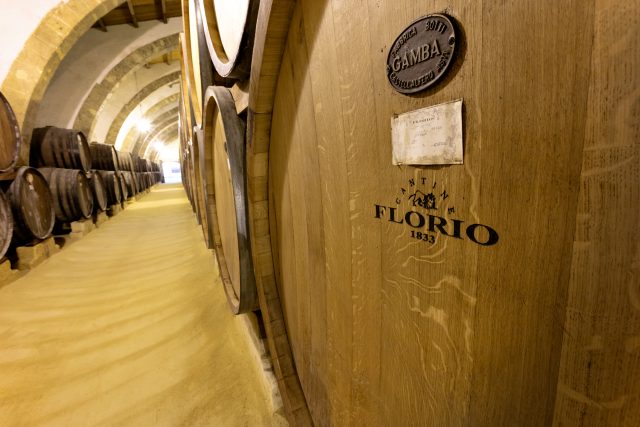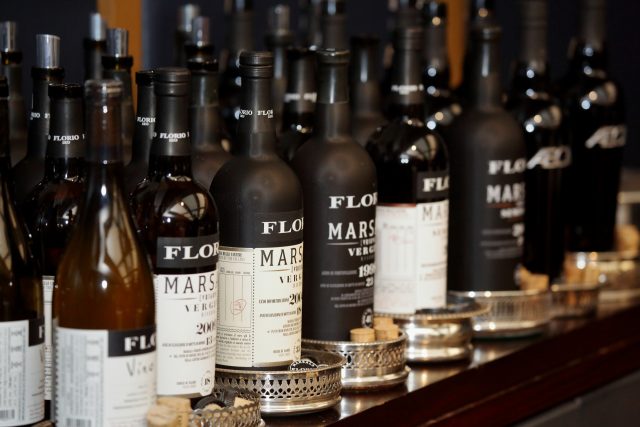This website uses cookies so that we can provide you with the best user experience possible. Cookie information is stored in your browser and performs functions such as recognising you when you return to our website and helping our team to understand which sections of the website you find most interesting and useful.
Florio maps out Marsala maturation
A masterclass last week from Florio director Roberto Magnisi and Italian wine expert Walter Speller revealed how cellar geography can influence the way Marsala ages.

Speller began the seminar by stating that, whereas the French definition of ‘terroir’ largely considers a vine’s growing environment, the Italian definition is somewhat broader: “It’s about grape variety, climate, culture and traditions…Humankind is very much a part of ‘terroir’, and that’s why Florio’s cellar plays an enormous role.”
While it is in the cellar, “a liquid art gallery” as Magnisi dubbed it, where Marsala goes beyond the world of wine, the role of the vineyard cannot be overlooked.
For Florio, Grillo is king, though a number of Sicilian grape varieties, both white and black, can be used to produce different styles of Marsala, ranging from Cataratto to Nerello Mascalese.
“All the elements of the grape have to perfectly ripened – skins, juices, pips and stalks,” explained Magnisi. “The objective is to steal the soul of the pips, to steal the soul of the skins, to steal the soul of the stalks.”
To maximise polyphenol extraction, which is essential to create Marsala with the robustness of structure to age, the presses exert up to 60 bars of pressure, approximately 20 times that of a pneumatic press.
“The world of Marsala is hard, extreme and oxidative,” explained Speller.
Before Marsala becomes Marsala as we know it, it goes through its first act as Alto Grado. Speller suggested that, rather than Marsala being a British invention, British visitors to the island in the late 18th century saw a business opportunity in this traditional, high-ABV still wine, catalysing the development of a Sicilian fortified wine industry. Florio was part of this process, being founded in 1833 by Vincenzo Florio.
At the tasting, Florio unveiled its own 15% ABV Alto Grado, Florio Vino. Magnisi noted that the purpose for making the wine was not to make money, but “to make the culture of Marsala clear”. While no vintage, varieties or indication of origin is provided on the label, it was revealed as a 2022 95% Grillo 5% Cataratto blend from 60-year-old vines planted very close to the sea, hence the wine’s notable salinity.

The world of Marsala is a complex one. It can come in a range of guises, from Fine and Superiore, which have the additions of sifone (for sweetness) and mosto cotto (for colour), to Vergine, which, as the name might suggest, is untouched by these alterations. The latter Magnisi described as “born from the love affair between wine and alcohol”. The alcohol in question is a 96% ABV grape spirit.
Time in oak is the other key distinction: Marsala Fine spends at least a year in oak, Superiore at least two, Superiore Riserva at least four, Vergine at least five, and Marsala Vergine Riserva is aged in wood for a minimum of a decade.
Sweetness can also vary, going from secco (dry) to dolce (sweet), as can colour, going from oro (gold) to ambra (amber), and rubino (ruby) for expressions made using black grapes.
Magnisi spoke about Florio’s cellar in a manner similar to how a winegrower might speak about a vineyard. At present there are 3,000 casks over a two hectare area, some five million litres of Marsala. The western side is just 95 metres from the sea and notably more humid and lower in temperature than the eastern one. As you go eastwards through the cellar, the humidity drops and the temperature rises. The precise temperatures and humidities will change with the seasons.
Of course, size does matter. Florio uses casks ranging from 225 litres barriques to 640 hectolitre barrels. Smaller vessels will be subject to changes caused by the surrounding environment than larger ones.
But, Magnisi argued that location is the decisive factor: “Oxidation can be accelerated and decelerated. If we want to slow it down, we work in the part closest to the shore…If we want to produce a Marsala that develops tertiary aromas quicker, then we work at the back of the cellar.”
This cellar-centric approach is what prompted Florio to release its Marsala’s New Geography range.

The first fortified example to be tasted, a Vergine Riserva, had been strengthened in 2009 – Florio does not date its Marsala according to harvest year, but rather by when the high-proof spirit was added. Aged in a 20hl cask in the western end of the cellar, the relatively large maturation vessel, proximity to the sea and relative youth as Marsala goes meant that it showed relatively little by way of tertiary aromas, but had detectable salinity.
By contrast, the next two Vergine Riservas to be tasted, fortified in 2004 and 1998 respectively, were dramatically different. The 2004 was, in Magnisi’s belief, an “aristocratic” expression that showed power in the glass. The 1998 was compared by some members of the press in attendance at the tasting to a Cognac. Fortified to 19% ABV, it has intensified over the last quarter century, losing 41% of its volume to the ‘angel’s share’. Noting the difference between the 2009 and 1998, Magnisi remarked: “The first Vergine Riserva you drink, this one one you chew.”
And then on to Semisecco Superiore Riserva. Despite both the 2015 and 2001 having a notable sugar content (80 grams per litre in the former, 85g in the latter, due to the addition of sifone and mosto cotto), the sweetness had been mitigated by time in oak. The 2015 has been slow to develop, having come from a cask in the Garibaldi Cellar, situated at the shore-end. The 2001 has had something of a head start and, having lost an angel’s share of 33% while in the cask, it has metamorphosed into something quite remarkable, with aromas of chestnuts and dark chocolate over an aniseed base.
The flight concluded with two examples of Florio’s Aegusa range, ‘Aegusa’ being the Ancient Greek name for the Favignana islands, which were purchased by Ignazio Florio in the late 19th century. Far from just being museum pieces, the 1964 and 1952, bottled 18 years ago, still showed life in the glass. Having the foresight to create drinks with an ageing potential of more than half a century is a testament to an approach Florio brands as “the oenology of listening”.
Magnisi concluded the tasting by remarking: “Marsala is often considered a dead project, but how can it be dead if you always have to look into the future?”
Speaking to db afterwards, Magnisi shared his thoughts on how Marsala can be marketed to the next generation: “We have to communicate how to enjoy it…The focus isn’t on the past, but the present and the future. Incredible examples [of marketing to younger consumers] are Sherry, Madeira and Port. They are used in pairings, or for an aperitivo. This is the magic formula to getting reacquainted with Marsala.”
As for pairings, Magnisi suggested prawns, tuna (both prepared in an Italian style and as sushi), and, an especially Sicilian pairing he noted, Marsala Vergine with oysters. Beyond seafood, he proposed the 2004 Vergine with aged cheeses or gorgonzola.
While the language of the cellar echoes that of a vineyard, that of Florio’s Marsala ageing and marketing is more reminiscent of the world of whisky than wine, both with the use of the term ‘angel’s share’ to describe the liquid lost over time and the bottle design. Magnisi suggested that this is because he considers Marsala in its own category altogether: “Marsala belongs between the world and wine and the world of spirits. The Marsala Vergine Riservva 2015 is very close to the world of wine – it’s very elegant, very agile. The Marsala Vergine Riserva 1998 is like a rum, a whisky – it’s only a comparison, but it’s a beautiful resemblance.”

